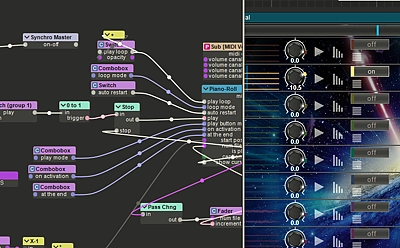The dark power of the MIDI harp
MIDI is a communication protocol dedicated to music, and used for transmitting information between electronic instruments, controllers, sequencers, and music software. It is also a file format containing MIDI instructions. Thus, the communication between instruments, machines, and software can be instantaneous or delayed. The MIDI file would be the digital equivalent of sheet music.
The MIDI protocol does not produce or transmit any sound. It consists solely of messages, including note messages, modulation commands, and program changes.
Therefore, this harp needs to be connected to a machine capable of interpreting this language; on its own, it is merely a silent harp.

Usine’s factory
The MIDI harp is thus connected to a powerful computer, a digital audio workstation. And the software that does all the work is called
Usine (the French word for factory
).
Of course Usine manages the MIDI protocol, but also digital audio up to 192 channels (in stereo, that's 2 channels), video, OSC, lighting effects, various sensors like Leap Motion, Wiimote, Joysticks, etc. It is a modular environment that includes network communication tools, remote control, scripts, hundreds of modules in all domains, from audio to mathematical functions to MIDI or video.
Thanks to its exceptional audio engine, Usine also allows integration of plugins, including virtual instruments, samplers and complex, sophisticated and real-time digital audio processing. XKTdra makes use of numerous plugins developed by GRM, IRCAM, UVI, Arturia, Native Instruments, but also develops its own systems.
The audio processing and programming are carried out by Vincent Michel